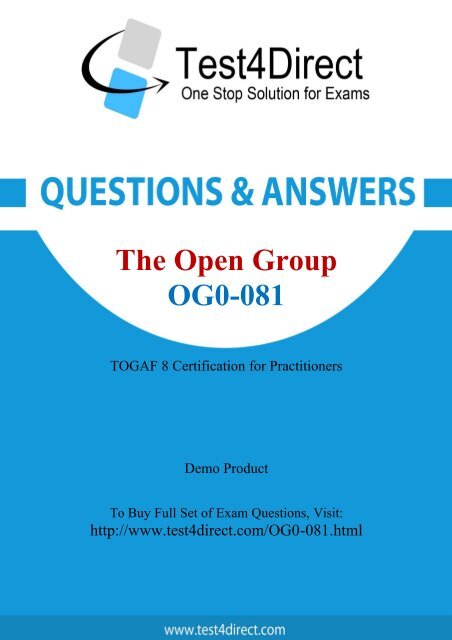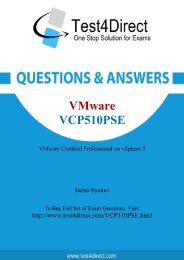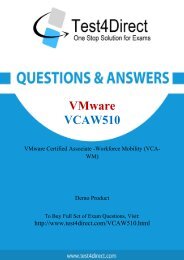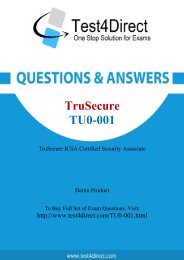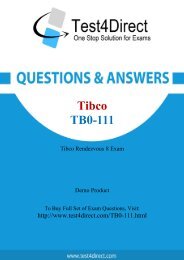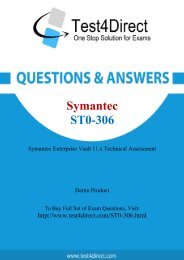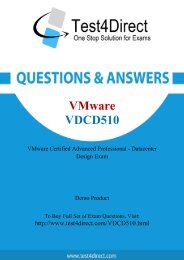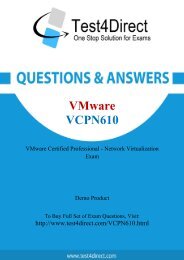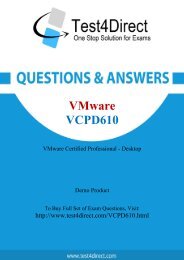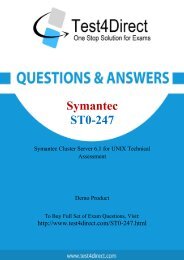OG0-081-demo
You also want an ePaper? Increase the reach of your titles
YUMPU automatically turns print PDFs into web optimized ePapers that Google loves.
The Open Group<br />
<strong>OG0</strong>-<strong>081</strong><br />
TOGAF 8 Certification for Practitioners<br />
Demo Product<br />
To Buy Full Set of Exam Questions, Visit:<br />
http://www.test4direct.com/<strong>OG0</strong>-<strong>081</strong>.html
Question: 1<br />
All of the following elements are required in the Application Architecture Baseline Document except<br />
____.<br />
A. architecture models of the candidate system(s)<br />
B. business and organization units supported<br />
C. precedent and successor applications<br />
D. owner(s) or business unit(s) responsible for requirements<br />
E. hardware and software platforms used<br />
Question: 2<br />
Question: 3<br />
Question: 4<br />
Answer: A<br />
Which of the following would be a potential downstream use of the qualitative criteria for the<br />
application architecture<br />
A. managing code quality<br />
B. generating service level agreements<br />
C. regression testing<br />
D. gap analysis<br />
E. All of the above<br />
The TOGAF Technical Reference Model _____.<br />
A. is intended as an example and should be tailored to the organization's needs<br />
B. must be used "as is" for developing comprehensive architecture models<br />
C. contains several industry specific frameworks<br />
D. is intended to contain the Enterprise Continuum<br />
E. contains only solution building blocks<br />
Which of the following statements about architecture principles is most true?<br />
Answer: B<br />
Answer: A<br />
A. Architecture principles must be tailored to the requirements of a given architecture project<br />
B. Architecture principles are intended to be enduring and seldom amended<br />
C. Architecture principles cannot transcend the organization's business strategies and objectives<br />
D. Executive Management can define principles as a means of enforcing compliance to its policies
and rules<br />
E. Due to their sensitive nature, architecture principles should be kept confidential<br />
Question: 5<br />
Question: 6<br />
Answer: B<br />
During Phase E - Opportunties and Solutions, a gap analysis can be used to compare the ____<br />
between<br />
the as-is and the to-be architecture.<br />
A. requirements<br />
B. Solution Building Blocks<br />
C. Architecture Building Blocks<br />
D. business functions<br />
E. standards<br />
What is the objective of Phase F?<br />
Question: 7<br />
Question: 8<br />
Answer: D<br />
A. To establish the IT Governance framework that will be used to direct deployment.<br />
B. To sort the implementation projects into priority order for implementation and migration.<br />
C. To implement change management processes that will be used to manage the implementation<br />
projects.<br />
D. To validate the architecture vision.<br />
E. All of these tasks<br />
What are the key inputs to Phase G - Implementation Governance?<br />
A. reusable solution building blocks<br />
B. statement of architecture work<br />
C. request for architecture work<br />
D. all of these items<br />
E. impact analysis<br />
Answer: B<br />
Answer: D<br />
As the ADM cycle is completed for a given architecture program, the architecture staff is responsible<br />
for<br />
____.
A. Project planning<br />
B. Final appraisal of the implemented architecture<br />
C. Ongoing monitoring of business and technology changes related to the architecture work<br />
D. Implementation Governance<br />
E. Internal marketing of the solution<br />
Question: 9<br />
When can new requirements be added to the requirement management repository?<br />
A. during each phase of the ADM<br />
B. at the Architecture Vision phase<br />
C. anytime during Phases A through D<br />
D. only upon completion of a business scenario<br />
E. when submitting the Request for Architecture Work<br />
Question: 10<br />
Who usually initiates a Request for Architecture Work?<br />
A. the sponsoring organization<br />
B. the architecture organization<br />
C. the CIO/CTO<br />
D. the architecture governance board<br />
E. senior management<br />
Question: 11<br />
A Technical Architecture Report should contain all of these items except ___.<br />
A. requirements traceability analysis<br />
B. project impact analysis<br />
C. technology architecture models<br />
D. technical specification for each building block<br />
E. gap analysis report<br />
Question: 12<br />
Answer: C<br />
Answer: A<br />
Answer: A<br />
Answer: B<br />
The final version of an Impact Analysis should contain all of the following except _____.
A. prioritized projects<br />
B. enhanced budget forecasts<br />
C. time ordered sequencing<br />
D. Implementation recommendations<br />
E. measures of effectiveness<br />
Answer: B<br />
Question: 13<br />
Which of the following would be a good example of an infrastructure application?<br />
A. Virtual Private Network<br />
B. System and Network Management system<br />
C. e-Mail<br />
D. Office (desktop) software<br />
E. All of these<br />
Question: 14<br />
In the high level Technical Reference Model ____.<br />
Question: 15<br />
Question: 16<br />
Answer: E<br />
A. all of these<br />
B. the application directly communicates to the outside environment<br />
C. the application communicates with the application platform through the communications<br />
infrastructure<br />
interface<br />
D. it is possible to analyze performance crtieria<br />
E. the communication infrastructure is very diverse<br />
The Architecture Continuum _____ the Solutions Continuum.<br />
A. drives<br />
B. is driven by<br />
C. is designed to satisfy<br />
D. is based on<br />
E. guides and supports the evolution of<br />
Answer: E<br />
Answer: E<br />
The U.S. Department of Defense C4ISR Architecture framework (now DODAF) provides an integrated
architecture model with three views. Which of these sets of views is provided?<br />
A. logical, physical, financial<br />
B. operational, technical, systems<br />
C. logical, physical, operational<br />
D. strategic, tactical, operational<br />
E. strategic, systems, operations<br />
Answer: B<br />
Question: 17<br />
Which of the following is not true about the nature of governance?<br />
A. All of these are characterisitics of governance.<br />
B. Provides guidance on the effective use of resources to achieve the organization's strategic<br />
objectives<br />
C. Ensure that all actions and related decisions are available to be examined by authorized parties<br />
D. All decisions taken, processes used and their implementation will not be allowed to create unfair<br />
advantage to<br />
any one particular party.<br />
E. All involved parties have a commitment to adhere to procedures, processes and authority<br />
structures established<br />
by the organisation.<br />
Question: 18<br />
Question: 19<br />
Answer: A<br />
In TOGAF's Architecture Governance organizational structure, which group is chiefly responsible for<br />
deployment and operations?<br />
A. domain architects<br />
B. IT service management<br />
C. Chief Information Officer/Chief Technology Officer<br />
D. program management office<br />
E. technical support<br />
Answer: B<br />
Typically, business goals and drivers have already been established and need only be validated. If this<br />
is<br />
not true, what process should be followed?<br />
A. Resequence the project to occur later in the overall program<br />
B. The team should work with the project sponsor to create a set of goals and objectives and to<br />
validate those
goals and objectives with top management<br />
C. The project team should create a set of placeholder goals and objectives<br />
D. Place the project on hold until a suitable set of business goals and objectives can be defined by top<br />
management<br />
E. Benchmark with a similar, noncompeting organization, and adopt their best practices for business<br />
goals and<br />
objectives<br />
Question: 20<br />
Answer: B<br />
During the Architecture Vision phase, what would be a typical source of enterprise wide constraints?<br />
A. The results of a detailed gap analysis<br />
B. The project plan for the given architecture activity<br />
C. External benchmarks<br />
D. The organization's business and architecture principles<br />
E. The architecture contract<br />
Answer: D
THANKS FOR TRYING THE DEMO OF OUR PRODUCT<br />
Visit Our Site to Purchase the Full Set of Actual <strong>OG0</strong>-<strong>081</strong> Exam Questions With Answers.<br />
http://www.test4direct.com/<strong>OG0</strong>-<strong>081</strong>.html<br />
We Also Provide Practice Exam Software That Simulates Real Exam Environment And Has<br />
Many Self-Assessment Features. Download Free Product Demo From:<br />
http://www.test4direct.com/<strong>OG0</strong>-<strong>081</strong>.html<br />
Money Back Guarantee<br />
Check Out Our Customer Testimonials


